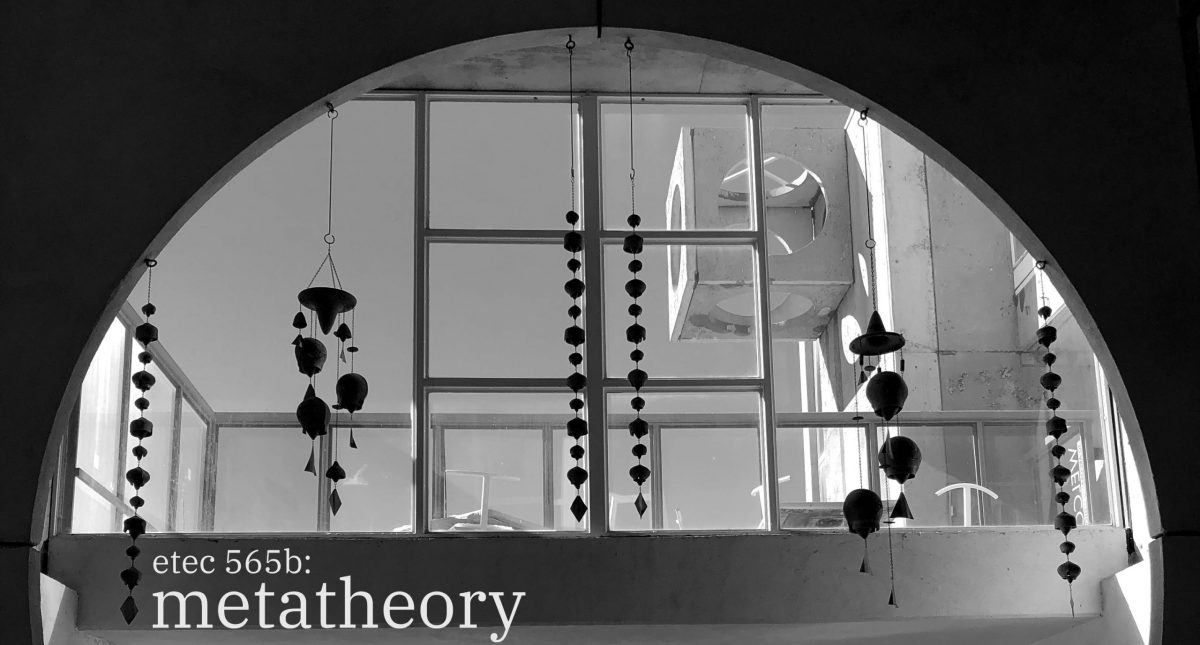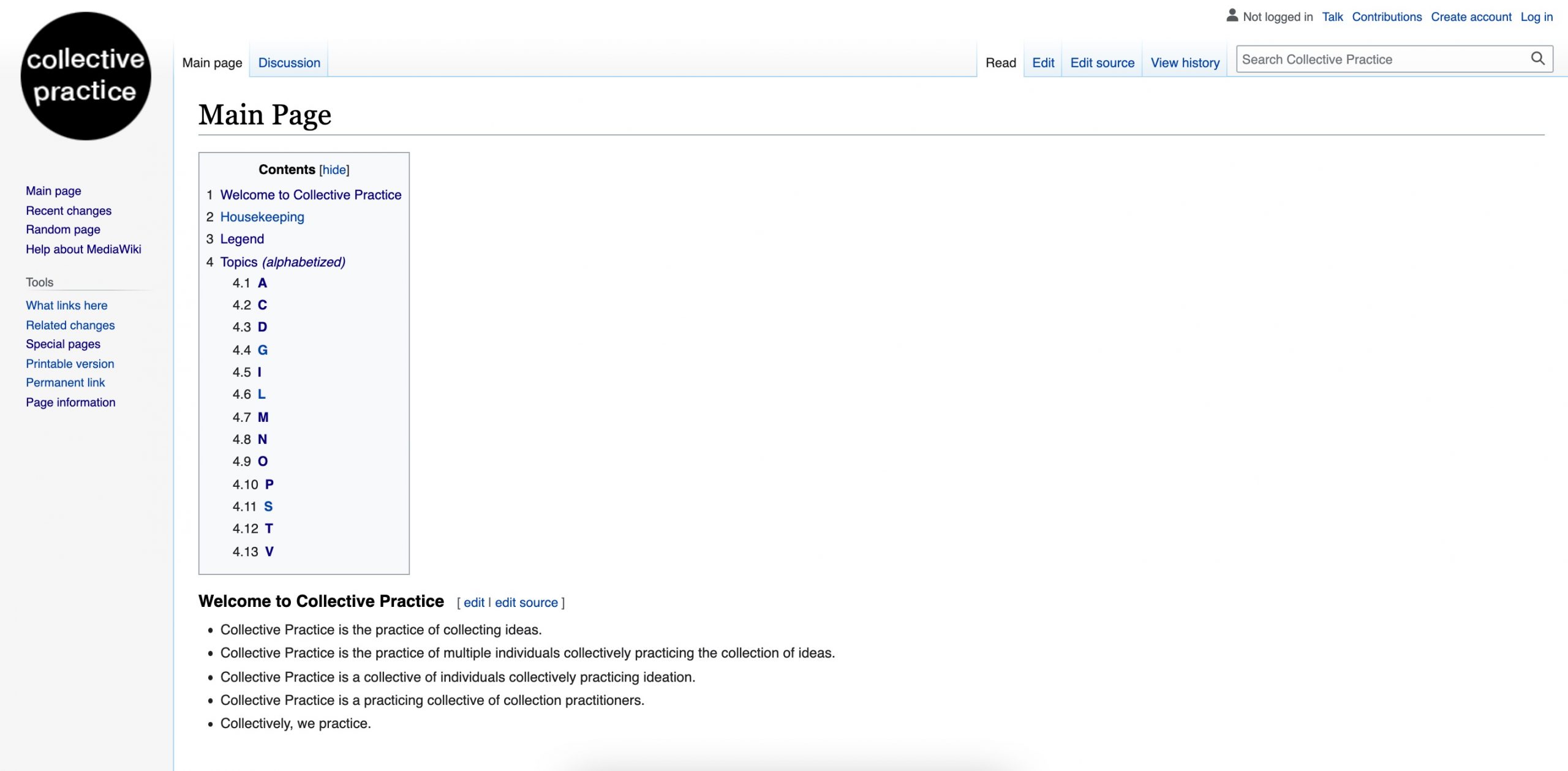The idea for Collective Practice* stemmed from a desire to create an online space to collect education-related information, experiences, and thoughts in an accessible and organized way. Initially, I was thinking about the concepts of “semiotic domains” (Gee, 2007, p. 18) and “affinity spaces” (p. 27): collaborative online domains for sharing topic-specific content amongst like-minded peers. I have carried the notion of the archive as a learning space throughout the MET program, yet for this project I was determined to create an online artefact that encompassed collaborative functionality. I believe Collective Practice does succeed functionally: it allows for multimodal content (text, hypertext, image, video, Google Sheets), it supports a folksonomy-style classification system, it is set up to function as truly collaborative, in that anyone can sign-in and edit any content within it, and it focuses on the inherently subjective thoughts and ideas of its users (so far, only me), rather than replicating the already abundant fact-centered online resources. Although this tool functions as intended, the value and utility of Collective Practice can only evolve and develop through regular, participatory use, and with such attention and time this archive has the potential to become an authentic affinity space.
When building the wiki, I heavily relied on the MediaWiki wiki, an extensive resource for using the software, with instructions for setting up a site, changing general aesthetics, adding skins to the visual appearance, and adding extensions to allow for multimodality.
My Contributions
I worked independently on this project; therefore, I was solely responsible for the creation of the wiki itself, including the research on different hosts, learning how to build a self-hosted wiki, experimenting with the basics of the PHP programming language to alter aesthetic, discovering how to add PHP extensions, and quickly familiarizing myself with the front end of the MediaWiki platform.
I created the Collective Practice logo, the explanatory text on the Main Page, the folksonomy-style tagging format, the alphabetical index, the housekeeping rules and guidelines and the icon-based legend that identifies the kinds of information on each topic page. I also initiated each of the available topic pages. The content on the topic pages was all created by me and can be sorted into four different categories: connected resources, past content, ongoing research, and new content.
Connected Resources: An important function of this tool was to organize, sort and categorize the various texts I have encountered throughout the MET program so that they become readily accessible to me. I went through each course’s texts (including texts from personal research), identified those I found meaningful, added their APA citation to a topic page on the wiki, then tagged and duplicated the information on all corresponding topic pages. This process was tedious, and time consuming, but it transfers the information that partially exists on paper and partially in memory, into a well-organized, and searchable archive. See: any topic page.
Past Content: Many of the topic pages are populated with past content created by me in previous MET courses that I modified be rewording and reformatting as prior to this, much of the content existed on various WordPress blogs, or on different platforms such as Tumblr and YouTube. The practice of reviewing, categorizing, and importing this information into Collective Practice began to highlight key themes of my own education theory. See: New Materialism, Art & Creativity, New Media.
Ongoing Research: While working on other assignments for this course, I inevitably collected resources that did not fit with the assignment at hand but appeared interesting for later viewing. Rather than save links in my favourites folder, I began gathering them under their associated topic within Collective Practice. This organized yet informal method of storing information was very exciting as I could immediately put my tool to use and see how the functionality is suitable outside the confines of this project for everyday use. See: Participatory, Deleuze & Guattari.
New Content: There are several memorable texts that I loosely keep in an unwritten list in my mind. They are at risk of being forgotten, never to be used either academically or in practice. As I have combed through past course tests, my aim is to identify those that require revisiting, and to summarize and conceptualize the most meaningful and practical aspects, then record my interpretations on the wiki so they become reliably accessible to me. As this practice will take some time, only one has been addressed to date, see: Neuroscience of Learning.
New Skills
I have investigated building a wiki in past MET courses but have been dissuaded by the web-hosted sites such as SlimWiki or Fandom. SlimWiki does not offer the required functionality without a substantial fee, and Fandom is overwhelmed with advertisements and obtrusive aesthetics. I have previously settled with Tumblr or Google Sites as both accommodate group projects well. When I saw there was an option to work alone, I took the opportunity to figure out how to make the wiki work without the stress of others relying on my tech skills, allowing me the freedom to explore. Through research and experimentation, I learned that the best way to host the exact kind of wiki I wanted was through self-hosting. I have slightly-above-basic knowledge of HTML and CSS and can re-configure Tumblr templates or build a Twine, but I have never worked with PHP before, or hosted my own wiki. I used my previous coding knowledge to get me through PHP, (along with a lot of Googling).
Purpose / Aesthetics / Function
At the time I wrote the project proposal for Collective Practice, I was doubtful that I would be able to find a wiki-based platform that operated as effectively as Wikipedia. A former, very popular wiki platform was Wikispaces, however it shut down in 2014, and this article, Wikispaces has closed. What are your alternatives? is what pushed me to figure out how to host my own MediaWiki site.
Although I enjoy the early web 2.0 aesthetic of Collective Practice, I did not intend it to look exactly like Wikipedia. The aesthetics do not change the functionality of the site, but I do believe they influence user perception of the web environment. I question, is it confusing that the site looks just like Wikipedia? Or would users feel comfortable in an environment they are already familiar with? There are options to upload different skins that alter the over-all appearance of the site, but after attempting to do this for several hours, I had to turn my focus to more pressing matters.
Metatheory
Collective Practice was initially conceived as a public place to store information that could be accessed by like-minded educators who may also wish to use and contribute to the information on the site. My focus for utilizing the wiki format was primarily about access and organization, but as I began to transfer content onto the site, it became clear how useful the tool was for documenting connections – the relations of things. As I created this wiki, I thought about how it fits with Latour’s notion of things as meeting places for discussion, or as “matters-of-concern” (Latour, 2005, p. 13), where a thing is perceived with fluidity and takes form as individuals’ unique subjectivities are celebrated and explored, rather than a thing as an immovable object forced into being a “matter-of-fact” (p. 13). The format of the wiki, such as its open access, editability and ease of connection building allow information to flow. Additionally, a resource based on connections reflects a New Materialist view of reality where every topic (or actor) is connected (or entangled) with many others, and how we come to understand each topic is through these relations. In this way, Collective Practice represents a working digital model of a certain kind of entanglement that has only just commenced its process of becoming.
References
Gee, J. P. (2007). Semiotic domains: Is playing video games a “waste of time?” In What video games have to teach us about learning and literacy, 17-45. New York: Palgrave and Macmillan.
Latour, B. (2005). From realpolitik to dingpolitik. Making things public: Atmospheres of democracy, 1444.
Notes
*The Collective Practice website has been deactivated to avoid paying monthly web hosting expenses, however the link provided shows a video of what the site looked like. If I can figure out how to host it for free, I will provide an updated link.

